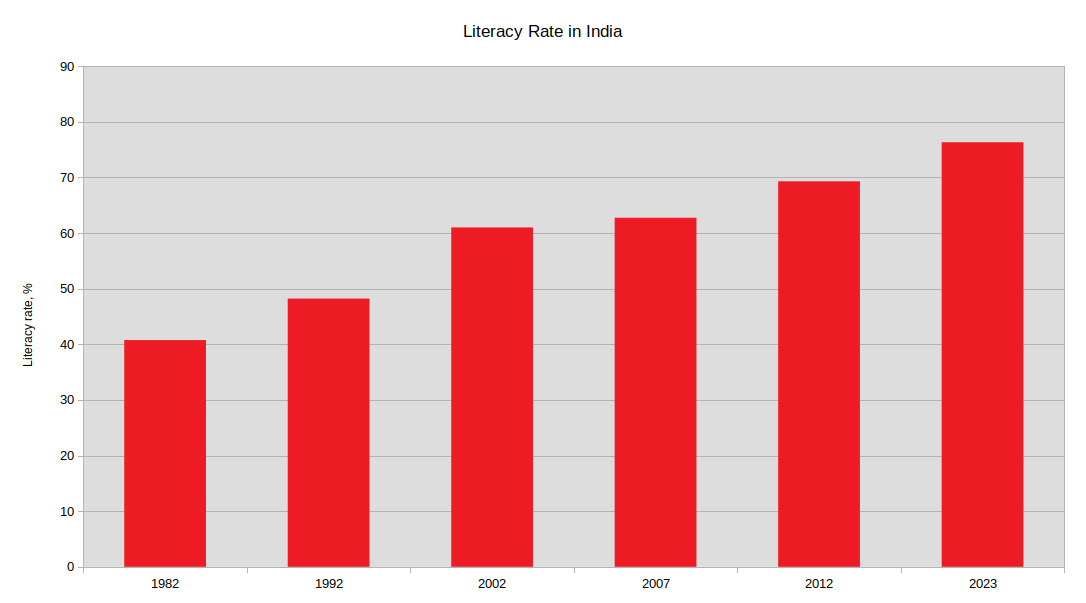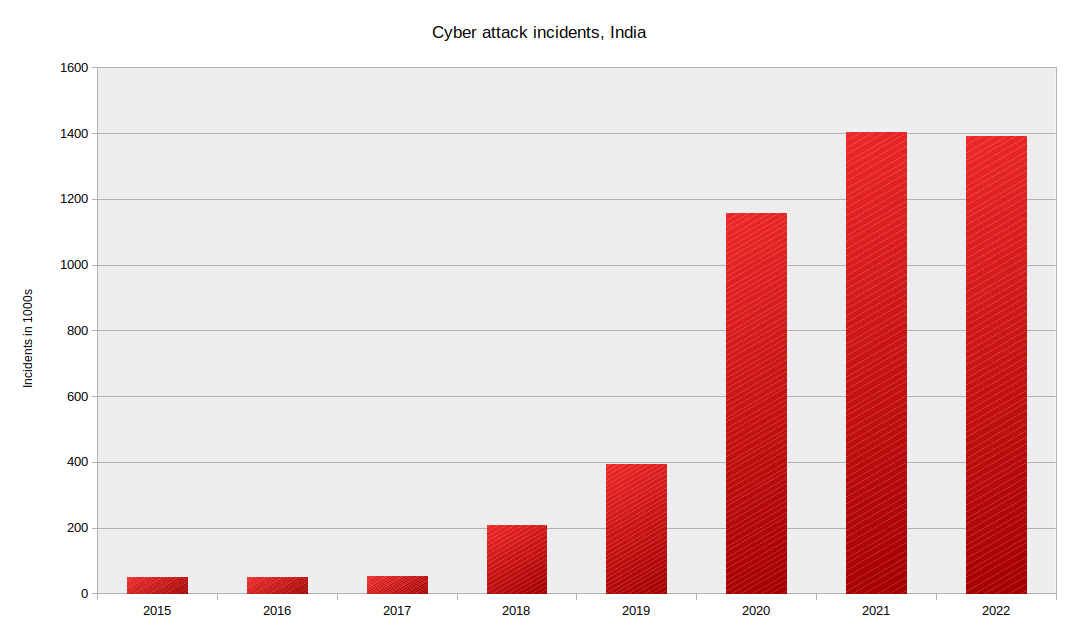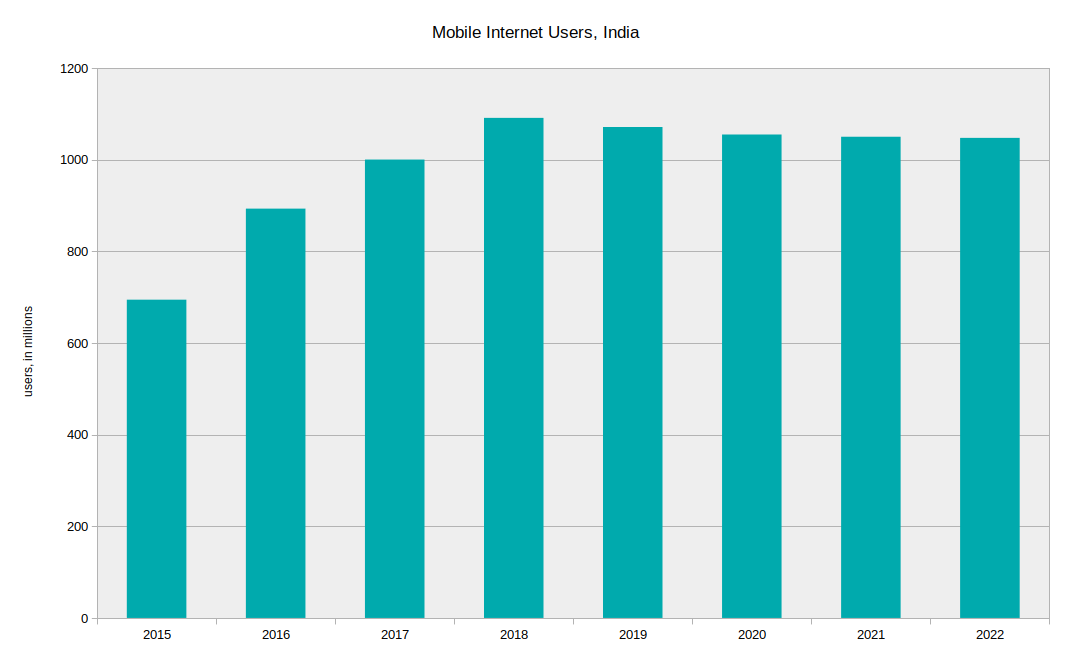India has been an independent, sovereign, country for the last several decades - but it became so under very difficult circumstances, with many challenges, whether in terms of very high poverty rates, territorial integrity issues, law and order situations, or even basic nutritional security, among several others. It also had extremely low literacy rates at the time for various reasons - whether it was because of a lack of awareness among the general population for its need, or the absence of institutions, or the deeply rooted casteism across the country, or many other varied reasons - but only about 12% the population had basic literacy skills.
One would think it a miracle that the literacy rate in India now stands at over 75%, which means that even with the rising population, a greater number of people have become literate over the years - which is by no means an easy feat to achieve for a newly liberated country with all its massive challenges. While a considerable period of time has passed by, one should not underestimate the level of humongous effort that needs to go in bringing basic literacy skills to a population of nearly a billion and a half. While the quality of the imparted reading and writing skills can certainly be questioned (and perhaps the definition of “literacy” too), there is one crucial aspect to consider in this regard, given that we are in a very different world today compared to 1947: dealing with the challenges of rapidly emerging and evolving digital technologies, and their incorporation into basic literacy skills - not only in India, but all around the world.
 Literacy rate in India over the past 4 decades (Source)
Literacy rate in India over the past 4 decades (Source)
What is digital literacy then?
While there is no clear definition of digital literacy, it can be thought of as broad skills encompassing the ability to operate standard digital technologies, and a rudimentary understanding of the basic elements of any digital system. The reason it sounds vague is that there is no clear “standard digital technology” - while the ability to use a Nokia 1100 could have been considered “digitally adequate” in 2004 - or the usage of social media platforms in 2012 - today the world has changed even more, and is changing so fast, that maybe by 2030 even having a good understanding of the usage of generative AI might seem woefully inadequate.
Moreover, the “Internet” back in the 1990s was just a collection of networks of webpages, whereas today it has evolved enough to almost become what Aaron Swartz would have called the “Semantic Web” i.e. a much more interactive web where a lot of the data available can be combined for more “meaningful” use - so the way one interacts with the Internet is quite different. One could even go so far as to say that a basic understanding of social media tools and platforms is essential in the context of digital literacy today.
Hence, considering the constantly evolving nature of digital tech, it can be hard to define “digital literacy” exhaustively, especially over time - but a person can certainly be equipped with tools and ideas to be able to gather information and familiarize themselves with new and emerging digital technologies. For instance, one need not be an expert on multi-factor authentication, but one has to be aware that their one-time password (OTP) is kind of “holy” and should never be shared with anybody, because of the basic principle of digital encryption.
Why do we need digital literacy in India?
In the Indian context, this element is crucial. The current population of 1.4 billion people is set to grow, and these digital literacy skills are more essential than ever - for a start, when you consider the very simple fact that 75% of the population is literate by the definition of “basic reading and writing skills” - it means that 25%, or roughly 350 million people, are not even able to read or write in any language. This is more than the entire population of the US and Canada combined!
Though it is startling, this fact itself would not have been such a major concern, say, 50 years ago, when the world was largely “offline” - but in modern times, when everything is going digital, be it government service deliveries or basic functioning of jobs in cities, and more importantly, considering that we live in a highly networked world - a substantial number of people are digitally disadvantaged because they are excluded from reaping the benefits of these new digital technologies. This can have major ramifications on society as a whole, and some considerable downstream effects too.
India has the largest youth population in the world, and that means there are a lot of people who are capable of gaining skills, creating firms, delivering services, and so on. And this is where, even when one considers purely the literate population, digital skills are quite important. There are so many industries that become accessible by gaining basic digital skills like handling emails, word processors, spreadsheets, databases, etc. that if the youth of the country are equipped with the required knowledge, society can change by leaps and bounds, and the future would look much more optimistic.
Even keeping the economic aspects aside, providing mere access to these technologies has a compounding effect - for instance, once you know how to use a search engine, it potentially opens up the world to you by giving you access to a virtually infinite pool of knowledge. Or if you learn how to automate basic file operations using scripting languages, you save a lot of time which you can use for other things that are more creative in nature. And when this idea is scaled to a wide population, the results are already clear to show in the form of innumerable open source software (the best example being the GNU/Linux operating system).
When one uses the videographic tools available on their smartphones, they can even provide an insight into life in parts of the country that people elsewhere could not imagine (for instance, PARI). In an age of big media houses dominating the narrative through various means, it is the availability of technological tools that makes independent media channels counter such actions and perform quality journalism. It is through technology that one can access live streams of court proceedings transparently and understand how the justice system works, which would otherwise be completely out of reach.
Digital vigilance is of increasing importance
There are of course, downsides to this rapid change in access to technology too. We already saw that there is a potential “digital divide” because of the varying levels of digital literacy in the country, which leads to exclusion of a large section of the population, particularly the elderly. There are not enough mature policies in place to handle digital idenitities, the concept of digital privacy, and so on.
It is quite a common experience to go to a restaurant or a shopping outlet and be asked for your phone number - and people give it away without much thought too. Scams are rampant; thousands of people are defrauded on a daily basis by bogus customer service agents and sales representatives. Phishing happens much more than you would think. In this regard, just gaining familiarity with digital tools and concepts may not suffice. We see that even within the confines of this article, we’ve already modified the definition of digital literacy - now we include awareness of digital misuse and digital vigilance in it too.
 Cyber attacks in India, 2015-2022 (Source)
Cyber attacks in India, 2015-2022 (Source)
Government policy actions and initiatives
Considering the complexities involved in digital literacy, carefully thought policies need to be drawn up, and broadly a lot of steps can be taken - but there is a constant need to periodically evaluate the next course of action.
Increasing the basic literacy rate
As mentioned before in the article, a significant number of people in India are still illiterate, and there is no point of looking at digital literacy without the basic foundation of literacy. A lot of old people were left out of formal education while growing up in a freshly independent India - and for such people to get the benefits of being able to read and write, the existing programmes from the Indian government (the Education for All programme from the Ministry of Education) can be allocated sufficient funds, for a start. Particularly, because of deeply entrenched historical issues, the literacy rate for women is abysmally low compared to men (64% vs 81% as per the Census of 2011), so the government needs to carry out appropriate campaigns to make sure it is addressed.
Additionally, for children growing up today, the government needs to ensure that good education programmes are designed so that parents don’t pull their children out of schools thinking it to be a waste of time - how that can be done requires a separate, elaborate discussion. The bottom line is: the literacy rate, no matter how much has been achieved, is still objectively low - and to even think of everyone getting access to the benefits of the digital age in an effective way, we need to make sure that we reach a nearly perfect literacy rate first.
Including the basics of digital literacy in school curricula
Currently, there is no structured way in which concepts surrounding digital literacy are taught to children while in school; children mostly learn from their peers organically. This is a bit strange, considering that as per the government, there are more than a billion mobile phone users in India, 600 million of them being smart phone users. The government can consider digital literacy as a public good and address it accordingly - the detailed contents can be worked out by appointing appropriate experts - but some essential, foundational knowledge of concepts like the internet, social media platforms, search engines, digital privacy, etc. can be imparted - and that too, not necessarily through classroom education, but using simple platforms like YouTube or NPTEL.
The goal is not to “teach” people how to use a browser or any particular application - it is to help people know how to approach any new concept in the digital space to understand it from the perspective of the principles involved (e.g. raising questions like “What is cryptocurrency, how is it different from money, why do so most governments not consider it official currency?”). This thought process will go a long way in shaping the way people interact with digital technology. Merely using a smart phone does not count towards digital literacy!
 Mobile internet users in India, 2015-2022 (Source)
Mobile internet users in India, 2015-2022 (Source)
Awareness of pitfalls
With any major change, there is almost always a set of unintended consequences. Likewise, with the advent of digital technology, there are various kinds of scams, cyber attacks, digital security breaches, etc. that have taken place, that one would never have imagined such things becoming major concerns a while back. Nevertheless, a lot of people are not very careful about their interactions with digital technology (e.g. giving away one-time passwords easily when asked, not questioning why a restaurant would want to know your contact details even if you go there without a reservation, and so on).
This is where a serious effort is needed by the government to make sure that people, at the very least, are aware of various ways in which they are digitally vulnerable. This could be through various channels like public service announcements, newspaper articles, billboard displays, etc. but it is very important at a societal level.
Legislative changes and enforcement
Keeping in mind the current limitations of the Indian government’s capacity to enforce the laws it makes, some basic and incremental legislative changes need to be brought in to provide a robust framework for digital privacy and data protection, starting with basic compliance requirements. Existing laws in other countries, like the GDPR, can be used as a reference and some of the basic provisions can be tailored for India’s context (there was such an act passed in India in 2023, but it has drawn its set of criticisms for not considering all stakeholders’ perspectives, and also some comparative studies with the GDPR).
Additionally, the nature of cyber crimes being very different from typical criminal activity, and also the innumerable grey zones involved, a separate government body (or perhaps even a ministry) needs to be instituted with experts in the field, with powers limited to enforcing simple digital compliance first (as opposed to the complex KYC requirements now); moreover, all stakeholders pertaining to digital services need to be involved in consensus building.
Reports of cyber crime need to be taken on a priority basis and addressed as soon as possible, and only after there is a sense of security while using digital services, can the government look at other matters like cryptocurrency regulation, “fact check units” (preferably not), and so on. As public policy scholars note, learn to walk before you can run.
The government may not have expertise in terms of knowing how to go about handling digital systems and innovation, and hence it would be a good idea to have partnerships with private players to foster a culture of digital exploration. This could be through funded hackathons, conferences, internships, and so on, so that a win-win situation can be reached - the government getting expertise in crucial new age technologies, companies getting platforms to showcase their innovations, and people getting opportunities to interact with industry players; admittedly, the balance can be a bit tricky to achieve (for instance, a company can try to wield undue influence through such means), but it can be deliberated upon iteratively.
Overall, this could lead to a lot of encouragement for the people to try out digital entrepreneurship, and possibly create an atmosphere of healthy competititon and innovation around digital technologies - and people who are outside this environment would also get a sense of encouragement for digital skills development by looking at success stories in this space.
The digital future
All said and done, the idea of a digital world is still quite new, and there are wild speculations all the time about the digital future and what can be considered “optimal” use of technology. However, for a start, it is certainly helpful to know the basics and understand at a fundamental level how the digital world works - and the implications of this at a societal level are not only huge, but extremely important for a sense of stability - not only in India, but all around the world.